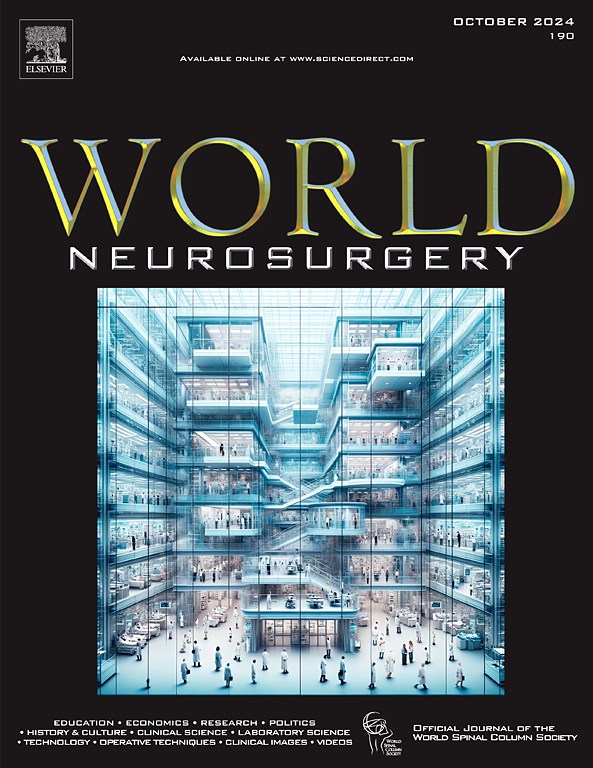Small Ruptured Anterior Communicating Artery Aneurysms in the Endovascular Right-of-First-Refusal Era: Intraprocedural Rupture Risk and Retreatment at Follow-Up
IF 2.1
4区 医学
Q3 CLINICAL NEUROLOGY
引用次数: 0
Abstract
Background
Ruptured small anterior communicating artery (ACoA) aneurysms can pose a technical challenge for endovascular therapy. We sought to explore treatment and follow-up results in the modern endovascular right of first refusal era.
Methods
Smaller (≤7 mm) ruptured aneurysms of the ACoA undergoing treatment were compared with non-ACoA counterparts and further dichotomized by size (≤3 mm and 3–7 mm). Immediate and 2-year angiographic results, procedural complications, retreatment, and functional results at follow-up were stratified by treatment modalities and compared between aneurysm location and size groups.
Results
Of 449 consecutive small ruptured aneurysms, 35% (n = 155) were ACoA. Endovascular treatment was the first-line option in 68%. While the immediate aneurysm occlusion was more favorable in the ACoA group compared to other aneurysms treated endovascularly (Raymond-Roy I-II, 89% vs. 74%, P = 0.003), the residual and/or recanalization requiring retreatment rate at 2 years was higher (27% vs. 17%, P = 0.04). ACoA aneurysms were associated with a 2-fold higher risk of retreatment (odds ratio [OR] 2.08, P = 0.02) in multivariate analyses of the endovascular cohort. The incidence of intraprocedural rupture was numerically higher for coiled ≤3 mm ACoA aneurysms (12.5% vs. 2.2%, P = 0.11), corresponding to a higher major complication rate (12.5% vs. 1.1%, P = 0.06) in this subgroup. Endovascularly treated ≤3 mm ACoA aneurysms were associated with a 4-fold higher risk of recanalization (OR 4.4, P = 0.01) and retreatment (OR 3.8, P = 0.03).
Conclusions
While the immediate efficacy is satisfactory for endovascularly treated small ruptured ACoA aneurysms, there are increasing needs for retreatment and non-negligible risks for coiling ACoA aneurysms ≤3 mm.
血管内优先优先权时代的小前交通动脉瘤破裂:术中破裂的风险和随访中的再治疗。
背景:破裂的小前交通动脉(ACoA)动脉瘤对血管内治疗提出了技术挑战。我们试图探讨在现代血管内优先权时代的治疗和随访结果。方法:将经治疗的ACoA小动脉瘤(≤7mm)与非ACoA动脉瘤进行比较,并进一步按大小(≤3mm和3-7mm)进行二分类。立即和2年的血管造影结果、手术并发症、再治疗和随访的功能结果按治疗方式分层,并比较动脉瘤位置和大小组之间的差异。结果:连续449例小破裂动脉瘤中,ACoA占35%(155例)。68%的患者首选血管内治疗。与血管内治疗的其他动脉瘤相比,ACoA组的立即动脉瘤闭塞更有利(Raymond-Roy I-II, 89%对74%,P= 0.003), 2年后需要再治疗的残余和/或再通率更高(27%对17%,P= 0.04)。在血管内队列的多变量分析中,ACoA动脉瘤与再治疗风险增加2倍相关(OR 2.08, P= 0.02)。盘状≤3mm ACoA动脉瘤的术中破裂发生率较高(12.5% vs. 2.2%, P= .11),对应于该亚组较高的主要并发症发生率(12.5% vs. 1.1%, P= .06)。血管内治疗≤3mm ACoA动脉瘤的再通风险(OR 4.4, P= 0.01)和再治疗风险(OR 3.8, P= 0.03)增加4倍。结论:虽然血管内治疗的小破裂ACoA动脉瘤的即时疗效令人满意,但对于≤3mm的ACoA卷曲动脉瘤,再次治疗的需求增加,且不可忽视的风险。
本文章由计算机程序翻译,如有差异,请以英文原文为准。
求助全文
约1分钟内获得全文
求助全文
来源期刊

World neurosurgery
CLINICAL NEUROLOGY-SURGERY
CiteScore
3.90
自引率
15.00%
发文量
1765
审稿时长
47 days
期刊介绍:
World Neurosurgery has an open access mirror journal World Neurosurgery: X, sharing the same aims and scope, editorial team, submission system and rigorous peer review.
The journal''s mission is to:
-To provide a first-class international forum and a 2-way conduit for dialogue that is relevant to neurosurgeons and providers who care for neurosurgery patients. The categories of the exchanged information include clinical and basic science, as well as global information that provide social, political, educational, economic, cultural or societal insights and knowledge that are of significance and relevance to worldwide neurosurgery patient care.
-To act as a primary intellectual catalyst for the stimulation of creativity, the creation of new knowledge, and the enhancement of quality neurosurgical care worldwide.
-To provide a forum for communication that enriches the lives of all neurosurgeons and their colleagues; and, in so doing, enriches the lives of their patients.
Topics to be addressed in World Neurosurgery include: EDUCATION, ECONOMICS, RESEARCH, POLITICS, HISTORY, CULTURE, CLINICAL SCIENCE, LABORATORY SCIENCE, TECHNOLOGY, OPERATIVE TECHNIQUES, CLINICAL IMAGES, VIDEOS
 求助内容:
求助内容: 应助结果提醒方式:
应助结果提醒方式:


